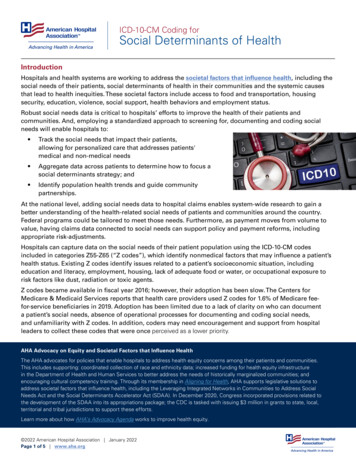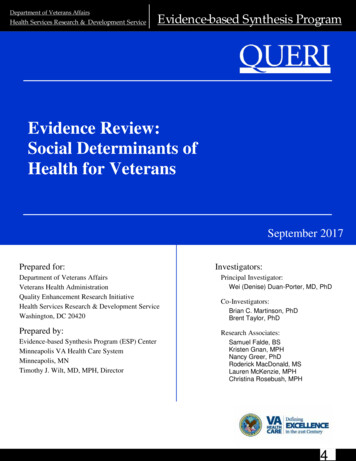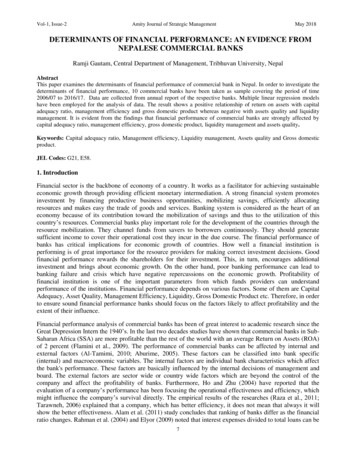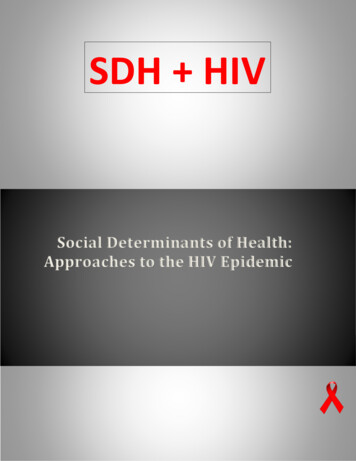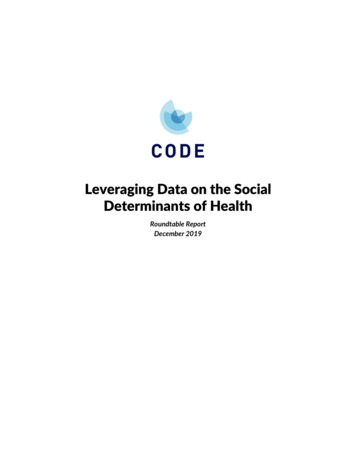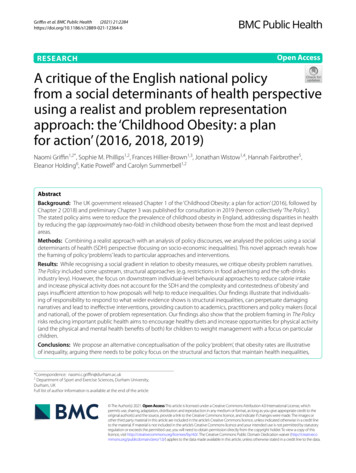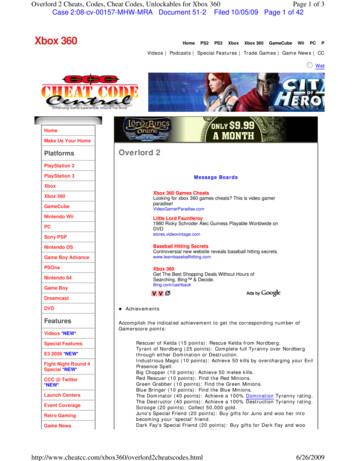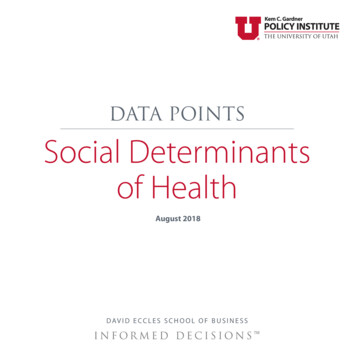
Transcription
Data PointsSocial Determinantsof HealthAugust 2018D AV I D E C C L E S S C H O O L O F B U S I N E S S
KEM C. GARDNER POLIC Y INSTITUTEWe are an honest broker ofINFORMEDRESEARCHthat guidesINFORMEDDISCUSSIONSand leads toINFORMEDDECISIONS
Social Determinants of HealthWhat are social determinants of health?The majority of a person's health is impacted by factorsoutside of the health care system: genetics, social,environmental, and behavioral. Social determinantsof health are the conditions in which people are born,live, learn, work, and play that affect a wide range ofhealth risks and outcomes. (HealthyPeople.gov)Utility NeedsFamily &Social SupportFoodInsecurityIncome tionSource: Intermountain Healthcare.Kem C. Gardner Policy Institute1
Life ExpectancyLife Expectancy at Birth by Utah Small Area, 2012-2016Note: Life expectancy can be used to gauge the overall health of a community.Source: Center for Health Data and Informatics, Utah Department of Health.2Social Determinants of Health
EducationUtah’s EducationalAttainmentAge 25 YearsAgeand Older,2016 and Older, 2016Utah’sEducationalAttainment25 16.3%15%8.4%10%5%0%Less than highschool graduateHigh school graduate(includes equivalency)Some college,Associate's degreeGeneral PopulationBachelor's degreeor higherPopulation Below PovertySource: Kem C. Gardner Policy Institute analysis of U.S. Census Bureau 2012-2016 American Community Survey 5-Year Estimates.Source: Kem C. Gardner Policy Institute analysis of U.S. Census Bureau, 2012-2016 American Community Survey 5-Year Estimates. CensusBelow poverty is defined as having poverty status anytime in the previous 12 months. Census Bureau uses a set of money income thresholdsthat vary by family size and composition to determine who is in poverty.PovertyUtah’s Percent of Population in Poverty, 2016Utah’sPercent of Population in Poverty, 7%15.9%10.2%9.1%5%0%White aloneBlack orAfricanAmericanaloneAmericanIndian andAlaskaNative aloneAsian aloneRaceNativeSome otherrace aloneHawaiianand OtherPacific IslanderaloneTwo ormore racesHispanic orLatinoorigin (ofany race)White alone,not Hispanicor LatinoEthnicityNote: Poverty is defined as having poverty status anytime in the previous 12 months. Census Bureau uses a set of money income thresholds that vary by family size andcompositionto determine who is in poverty.Source: Kem C. Gardner Policy Institute analysis of U.S. Census Bureau, 2012 2016 American Community Survey 5 Year EstimatesSource: Kem C. Gardner Policy Institute analysis of U.S. Census Bureau 2012-2016 American Community Survey 5-Year Estimates.Kem C. Gardner Policy Institute3
Employment OpportunitiesJob Growth and Decline: Change in employment since 2007 peak, Q4 2007 – Q4 2017More jobs than 2007Fewer jobs than 2007Source: Kem C. Gardner Policy Institute analysis of U.S. Bureau of Labor Statistics (BLS) Quarterly Census of Employment and Wages data.4Social Determinants of Health
HousingPercent of All Households with Severe Housing Cost Burden by Income in UtahHouseholds %of Median IncomeHoseholds with SevereCost Burden 30%30% 50%51% 80%81% 100% 100%TotalHouseholds% with SevereCost BurdenAll Households Below the 6,935All Households Above the Median Income3,290428,30563.4%28.0%8.0%3.1%0.08%Note: A household that pays 50 percent or more of their income on housing costs is considered severely cost burdened.Source: HUD Comprehensive Housing Affordability Strategy (CHAS), 014.Food InsecurityPercent of Population with Food Insecurity in Utah, 2016Percent of Total Population with FoodInsecurity in Utah, 201612.5%Percent of Children with FoodInsecurity in Utah, 2016Overall,382,49015.4%Children,142,320Note: At the national level, 12.9% of the total population is food insecure and 17.5% of children are food insecure.Source: Feeding America, Map the Meal Gap.Source: Feeding America Map the Meal Gap.Kem C. Gardner Policy Institute5
Race/EthnicityPopulation Growth by Race and Ethnicity, 2016 to 2017NH Black7%Total populationchange: 60,585NonHispanicWhite59%NH Asian15%Minority41%Note: NH Non-Hispanic or Latino.Source: U.S. Census Bureau, Population Division, June 2018.6NH AmericanIndian orAlaska Native2%Hispanic58%NH Two orMore Races14%NH NativeHawaiian orPaci cIslander4%Source: Kem C. Gardner Policy Institute analysis of U.S. Census Bureau,Population Division, June 2018.Social Determinants of Health
CrimeCrime Rates per 1,000 Population, 2016Crime rate includes homicide, rape, robbery, aggravated assault, burglary, larceny, motor vehicle theft, and arson.Source: 2016 Crime in Utah Report. Utah Department of Public Safety.Kem C. Gardner Policy Institute7
Health Care ResponsibilityWhoisisprimarilyprimarily responsiblehealthfrom rspective of patients, physicians, and 3%Employers44%75%The PatientThe Health Care ProviderThe Health Care System25%The Insurance CompanyThe EmployerSource:StateValueof Valuein U.S.TheHealthUniversityof UtahSource:TheBringingInto Focus:StateCare.of Valuein U.S. HealthCare.Health.(2017). University of Utah Health. Data from University of Utah Health Value in Health Care Survey. Conducted by Leavitt Partners between May 25 and July 14, 2017. Question response size: patients - 1,607; physicians - 345; employers - 216. Survey participants were asked this as a followup question if they selected “My Health Improves” as one of the top five statements that best reflects what they value most when getting services from a health care provider.ReferencesEgede, L. (2006). Race, Ethnicity, Culture, and Disparities in Health care. Journal of General Internal Medicine. 21(6): 667-669.Gundersen, C., Ziliak, J. (2015, November). Food Insecurity and Health Outcomes. Health Affairs, 34(11): Food & Health.Marmot MG, Wilkinson RD, editors. (2006). Social Determinants of Health, 2nd Edition. Oxford, England: Oxford University Press.National Center for Health Statistics. (2017). Health, United States, 2016: With Chartbook on Long-term Trends in Health. Hyattsville, MD: U.S.Department of Health and Human Services, Centers for Disease Control and Prevention.Robinson, F., Keithley, J. (2000). The Impacts of Crime on Health and Health Services: A Literature Review. Health, Risk & Society, 2(3), 253-266.Social Determinants of Health. (2018, July 25). Retrieved from es/topic/socialdeterminants-of-health8Social Determinants of Health
Kem C. Gardner Policy Institute Staff and AdvisorsLeadership TeamNatalie Gochnour, DirectorJennifer Robinson, Associate DirectorDianne Meppen, Director of Survey ResearchPamela S. Perlich, Director of Demographic ResearchJuliette Tennert, Director of Economic andPublic Policy ResearchJames A. Wood, Ivory-Boyer Senior FellowFaculty AdvisorsAdam Meirowitz, Faculty AdvisorMatt Burbank, Faculty AdvisorSenior AdvisorsJonathan Ball, Office of the Legislative Fiscal AnalystGary Cornia, Marriott School of BusinessDan Griffiths, Tanner LLCRoger Hendrix, Hendrix ConsultingJoel Kotkin, Chapman UniversityDarin Mellott, CBREDerek Miller, World Trade Center UtahChris Redgrave, Zions BankBud Scurggs, Cynosure GroupWesley Smith, Western Governors UniversityStaffSamantha Ball, Research AssociateMallory Bateman, Research AnalystDJ Benway, Research AnalystMarin Christensen, Research AssociateMike Christensen, Scholar-in-ResidenceJohn C. Downen, Senior Managing EconomistDejan Eskic, Senior Research AnalystEmily Harris, Demographic AnalystMichael T. Hogue, Senior Research StatisticianMike Hollingshaus, DemographerThomas Holst, Senior Energy AnalystMeredith King, Research CoordinatorColleen Larson, Administrative ManagerShelley Kruger, Accounting and Finance ManagerJennifer Leaver, Research AnalystAngela Oh, Senior Managing EconomistLevi Pace, Senior EconomistJoshua Spolsdoff, Research EconomistLaura Summers, Senior Health Care AnalystNicholas Thiriot, Communications DirectorNatalie Young, Research Analyst
Partners in the CommunityKem C. Gardner Policy Institute Advisory BoardThe following individuals and entities helpsupport the research mission of theKem C. Gardner Policy Institute.ConvenersLegacy PartnersBoardThe Gardner CompanyIntermountain HealthcareKSL and Deseret NewsLarry H. & Gail Miller Family FoundationMountain America Credit UnionMitt and Ann RomneySalt Lake City Corp.Salt Lake CountyUniversity of Utah HealthUtah Governor’s Office ofEconomic DevelopmentZions BankScott Anderson, Co-ChairGail Miller, Co-ChairDoug AndersonDeborah BayleCynthia A. BergRoger BoyerWilford ClydeSophia M. DiCaroCameron DiehlLisa EcclesSpencer P. EcclesMatt EyringKem C. GardnerChristian GardnerExecutive PartnersThe Boyer CompanyIvory HomesMark and Karen BouchardSalt Lake ChamberSorenson Impact CenterWCF InsuranceSustaining PartnersMichael O. LeavittMitt RomneyClark IvoryRon JibsonMike S. LeavittKimberly Gardner MartinDerek MillerAnn MillnerSterling NielsenCristina OrtegaJason PerryGary B. PorterTaylor RandallJill Remington LoveBrad RencherJosh RomneyCharles W. SorensonJames Lee SorensonVicki VarelaRuth V. WatkinsTed WilsonNatalie Gochnour, DirectorEx OfficioSenator Orrin HatchGovernor Gary HerbertSpeaker Greg HughesSenate President WayneNiederhauserRepresentative Brian KingSenator Gene DavisMayor Ben McAdamsMayor Jackie BiskupskiKem C. Gardner Policy Institute Health Care Advisory CouncilNathan CheckettsEdward ClarkJoseph MinerMikelle MoorePhillip SingerEric HalesClyde CompaniesDominion EnergyStaker Parson CompaniesKem C. Gardner Policy InstituteIThomas S. Monson Center 411 E. South Temple StreetSalt Lake City, UT 84111 801-585-5618 gardner.utah.eduIIDAV I D E CC L E S S C H O O L O F B U S I N E S SUNIVERSITY OF UTAHStephen L. WalstonChad Westover
Social Determinants of Health Data Points August 2018. KEM C. GARDNER POLICY INSTITUTE . work, and play that affect a wide range of health risks and outcomes. (HealthyPeople.gov) Utility Needs Primary Secondary . Thomas S. Monson Center I 411 E. South Temple Street Salt Lake City, UT 84111 I 801-585-5618 I gardner.utah.edu
